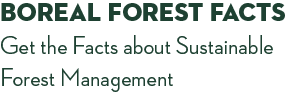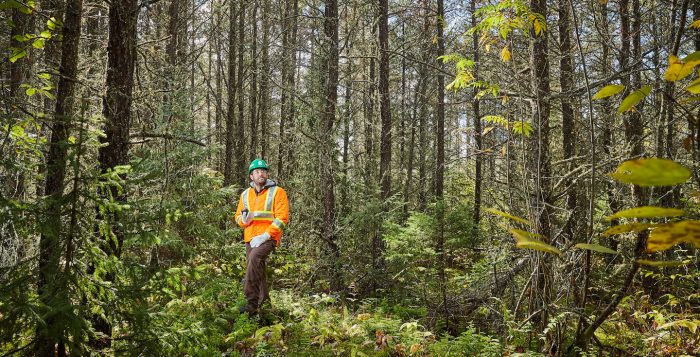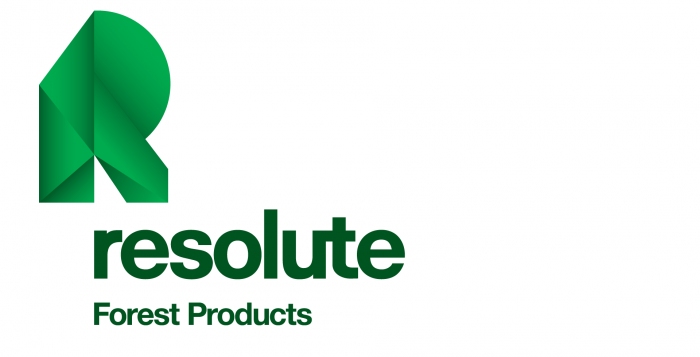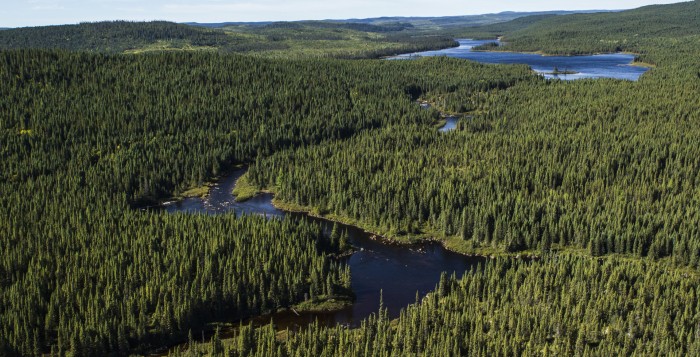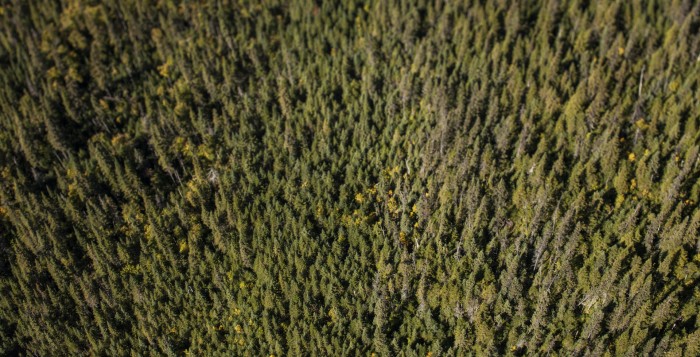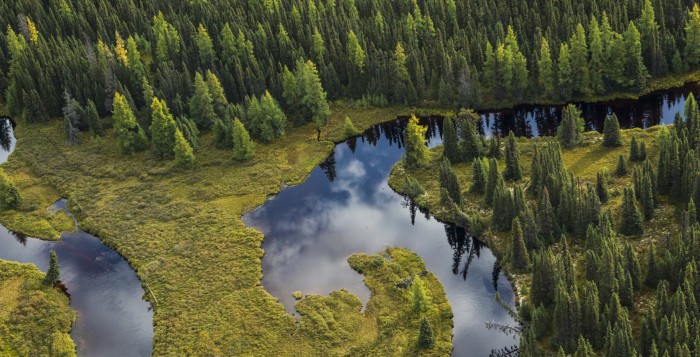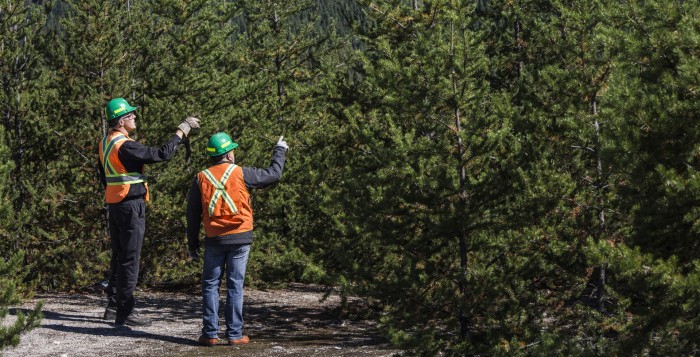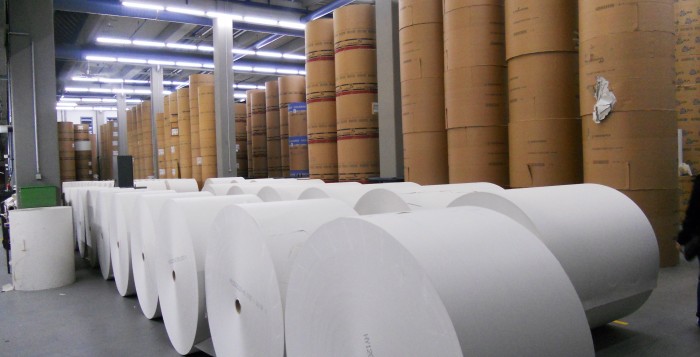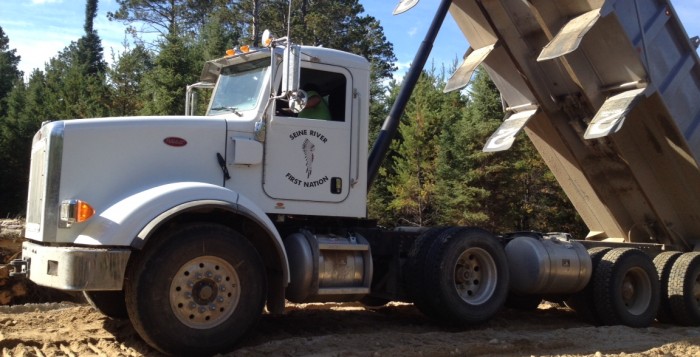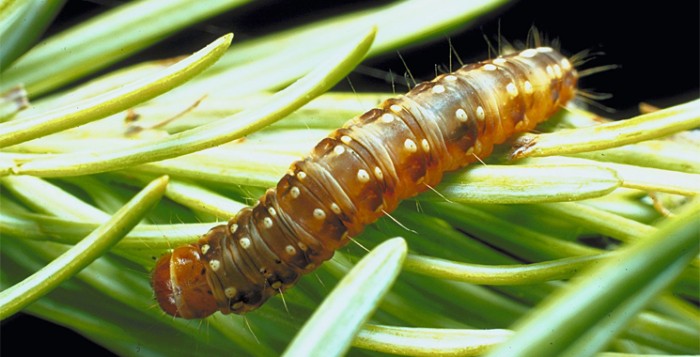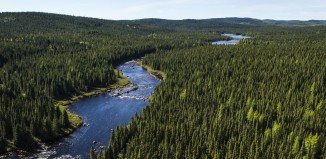This digital resource is managed by Resolute Forest Products. We are one of the largest forest products companies in North America, supplying customers in nearly 70 countries with pulp and paper materials to make products we all use – products like newspapers, magazines, books, printing and writing papers, tissues and building materials.
Having operated in Canada’s boreal forest for many decades, we understand the importance of preserving and renewing it for future generations.
We have created this website to answer some commonly asked questions about Canada’s boreal forest.
If you’d like to join the conversation about sustainable development in Canada’s boreal region, please visit Boreal Forum.
Canada’s boreal region covers almost 60 percent of the country’s land area, essentially spanning from the Atlantic to the Pacific. At 2,000,000 mi², (over 5,740,000 km²), it is one of the largest and most complex ecosystems on the planet.
The boreal forest is fantastically diverse and complex. An ecosystem of lakes and wetlands moderates the climate, produces oxygen and purifies the water supply for its inhabitants. Much of the world’s freshwater is in the boreal’s lakes, rivers and streams. More than 208 billion tons of carbon are stored in the boreal’s trees, soils, water and peat, meaning that the forest has a significant impact on the planet’s ability to regulate the levels of carbon in the atmosphere.
According to Natural Resources Canada, “Canada’s boreal forest is often portrayed as one vast tract of ancient, pristine wilderness but this isn’t the case. Although the boreal region itself is ancient, the boreal forest is made up mostly of trees that are relatively young compared with many that grow in more temperate climates. It is regularly affected by forest fires, insects and other natural disturbances, but continually renews itself through these natural disturbances.”
Canadian Boreal Species
- The Canadian boreal is home to a rich variety of tree species including Balsam Fir, White Birch, Poplar, Black and White Spruce, Jack Pine, Red Pine and Eastern White Cedar.
- The region is home to more than just millions of acres of trees and wetlands — thousands of species of animals, birds, plants and insects thrive in its habitat.
- Millions of land birds call the boreal region home, either permanently or as seasonal migrants. Among other species, the boreal is home to owls, hummingbirds, woodpeckers, vultures, hawks, kingfishers and songbirds.
- Large mammal species in the Canadian boreal include caribou, deer, moose, wolves, and black bears.
- Countless smaller mammals also call the boreal home, including foxes, lynx, raccoons, porcupines, hares, beavers, ermines, muskrats, pine marten, squirrels and bats.
- Then there are the boreal’s insects, which include beetles, dragonflies, grasshoppers, bees, ants and—if you’ve had the chance to see them in person – spectacular butterflies.
Sustaining Whole Communities: Economic Impact of the Boreal
- The forest products industry has been an important part of the Canadian economy for generations, and Aboriginal communities have relied on the boreal for millennia.
- The forest products industry has a unique responsibility to understand and protect the forest and to study how best to ensure its viability as a source for natural, economic and social development.
- The forest products industry has an outsized impact on the livelihoods and wellbeing of many Canadian communities. More than 600 Canadian communities rely on forestry. Half of those depend on forestry for at least 50% of household income, and about 160 of those communities are solely reliant on forestry.
- 70% of Aboriginal communities in Canada are located in forested regions.
- There are about 17,000 First Nations people working in Canada’s forest products sector and the sector’s activities involve more than 1,400 Aboriginal businesses.
- Canada’s forest products industry is a $67 billion dollar (CAD) a year industry.
- Canada’s forest products industry provides 230,000 direct jobs and almost 1 million indirect jobs across the country.
- Our industry pays wages that are, on average, 16 percent above the national average, which helps sustain the economic health of hundreds of villages, towns and cities.
- The products we produce are an important link between the United States and Canada, as the U.S. is by far the largest importer of Canadian forest products – used to produce products like newspapers, magazines, books, printing and writing papers, tissues and building materials.
The boreal forest is one of the great wonders of the natural world. It spans much of the Northern Hemisphere, from North America and Asia to parts of Europe, and is considered public land. The forest is home to unique plants, animals and human cultures that have coexisted for thousands of years. Those of us who live and work in Canada’s boreal region consider it a critical part of our culture, economy and collective future.
Resolute is a responsible forest manager, operating along with other Canadian forest products companies in a highly regulated environment.
Forest Certification
Forest certification and fiber tracking help to ensure the sustainability of our fiber supply and other forest values, including biodiversity conservation and ecosystem services.
Here are some of the highlights of our work in responsible forest management and wood fiber sourcing:
- 100% of the woodlands we manage are third-party certified to internationally recognized certification standards.
- 100% of Resolute’s manufacturing facilities have a CoC tracking system compliant with the Sustainable Forestry Initiative® (SFI®), the Programme for the Endorsement of Forest Certification (PEFC) or the Forest Stewardship Council® (FSC®), all of which require that 100% of the fiber processed meets minimum due diligence requirements related to risks of illegal logging and other important sustainability issues.1
- 93% of the wood supply for sawmills and 52% of virgin wood fiber inputs for pulp and paper mills are certified to internationally recognized standards.
For details on Resolute’s forest management certification, see here.
Forest Management Planning
In Ontario, Canada, as required by the laws and regulations of the province, Resolute prepares 20- year forest management plans that are updated every five years in collaboration with government and other stakeholders. Public consultation is part of the planning process and critical for the development of collaborative forest management strategies, which ensure that social needs are satisfied and values are protected.
Here’s a closer look at how Resolute plans forestry operations.
First, we develop comprehensive plans with regards to where we harvest. In Canada, we work on public lands, and only a small portion of the boreal is open to harvesting. The boreal forest is one of the world’s most carefully managed forests, and we make sure to comply with all of the stringent regulations that govern it.
This involves:
-
- Picking the right spot: Drawing on hundreds of maps, comprehensive wildlife surveys and decades of data, we block off areas where harvesting might conflict with traditional activities of First Nations (Native Canadians), consider the impact on wildlife habitat and take into account the area’s topographical features (for example, proximity to a river).
- Mimicking nature’s method: We emulate natural disturbances in order to optimize forest regeneration.
- Harvesting only certain trees: In the boreal, Resolute primarily works with softwood species such as black spruce, white spruce, jack pine and balsam fir. We also work with some hardwood species such as white birch and poplar. All these species require little to no help to regenerate quickly and abundantly. One exception is jack pine, which requires high temperatures (such as in the case of a forest fire) for its cones to release seeds.
Reforestation work begins soon after a harvest. To learn more about forest regeneration, click here.


An abundance of natural regeneration often results in the necessity to perform a “spacing” operation at age 10 to 15.
Returning regularly to ensure regeneration
Over several years following a harvest, we return regularly to the area to ensure that regeneration is progressing well, and to perform corrective measures if needed.
While many companies are looking to shrink their carbon footprints, Resolute believes that it has a special obligation to do so because we live and work among the very forests that help to manage the world’s climate. To that end, we’ve set an ambitious target to reduce our scope one and scope two greenhouse gas emissions, and we continuously seek ways to improve our energy efficiency.
We’ve Cut CO2 Emissions Dramatically
- As part of the World Wildlife Fund (WWF) Climate Savers program, Resolute has committed to reducing its scope one and scope two greenhouse gas emissions by 65 percent by 2015 (base year 2000). This is an industry-leading target and is the equivalent of taking 1.45 million cars off the road. We are delighted to share that we expect to achieve this goal ahead of schedule.
- About 70 percent of our energy requirements come from renewable sources. While hydroelectricity is the primary source, eight of our sites operate cogeneration facilities producing “green energy” from carbon-neutral biomass.
- We use alternative fuels like methane from landfills, used oil, and tire-derived fuel in an effort to avoid waste.
- Our AlignTM product line has a carbon footprint that is 35-86 percent lower than the average competitive paper.
More CO2 Cuts Planned
- Industry-wide, we’re looking at ways to better utilize organic waste products. Between 2007 and 2009, industry usage of biomass material grew from 58 percent to 68 percent of energy used. This means our reliance on the fossil fuels that contribute to climate change has declined substantially, while our ability to reuse waste material has increased.
- On August 22, 2013, Gaz Métro, Resolute Forest Products and the town of Saint-Félicien announced a new natural gas line that will enable Resolute`s Kraft pulp mill in Saint-Félicien to replace heavy oil with a cleaner form of energy. The total investment regarding this project is 17 million dollars. By switching to natural gas, our Saint-Felicien Kraft mill will reduce its greenhouse gas emissions by 17,000 tons every year, the equivalent of emissions produced by 5,000 automobiles. The new line will be 22 kilometers long, and the construction process will be completed by December 2013.
- Resolute recently announced the construction of a wood pellet plant that will convert left-over wood fibers — an underutilized bi-product of our work — into a reliable source of renewable energy. This will be the largest power plant in North America fueled entirely by biomass and will contribute significantly to reducing greenhouse gas emissions.
The boreal forest has fed, clothed and housed humans for thousands of years. Today, it continues to be a source for people’s livelihood through direct employment – in harvesting and regenerating forests, and in manufacturing operations – and indirect employment; the grocery stores, schools, hospitals and thousands of other businesses and organizations that depend upon boreal communities.
Boreal Forest Economic Facts
- More than 233,800 Canadians are directly employed in forestry jobs, and more than 600,000 Canadians rely on the industry for their livelihoods.
- The forestry sector’s contribution to Canada’s GDP was $24 billion dollars CDN in 2012, or nearly 2 percent of the entire Canadian GDP (and 12 percent of Canada’s manufacturing GDP).
- Over 800 First Nations communities are located in Canada’s boreal region, and an estimated 17,000 First Nations people in Canada make their living in the forest products industry.
- The average wage of a forest products industry employee is $52,673, or 16 percent above the national Canadian average. The Canadian forest products industry pays roughly $9 billion in wages annually.
- The industry is a vital contributor to trade between Canada and the United States — the U.S. alone counts for 65 percent of Canada’s wood and paper product exports for use in a range of products, from printing paper to building materials to packaging to labels and advertising.
Preserving these communities and their way of life is a major reason why the industry has invested so heavily in science-based conservation of forests to ensure environmental, social and economic sustainability.
The forest products industry has dramatically improved its sustainability and forest conservation performance in the past few decades, from reducing its carbon footprint to putting sustainable forest management practices in place. Resolute Forest Products adheres to some of the most rigorous fiber sourcing standards in the world, and our customers can rest easy knowing that the products they use come from responsibly managed forests.
Sustainable Forestry Measures
- 100 percent of the woodlands we manage have been certified to one or more internationally-recognized sustainable forest management standards.
- All of our mills in Canada and the U.S. have fiber-tracking systems in place that allow us to identify the source of the fiber or wood used. Most of these tracking systems are third-party certified according to one or more of these internationally recognized chain of custody standards: Forest Stewardship Council® (FSC®), Sustainable Forestry Initiative® (SFI®) and Programme for the Endorsement of Forest Certification (PEFC).
- We prepare or contribute to the development of 20- or 25-year forest management plans that are revised every five years. Public participation is a critical part of the process, and we encourage First Nations and local communities to participate in the planning process.
- Regeneration is an essential part of sustainable forest management. As a responsible forest manager, Resolute seeks to respect the natural growth cycle of trees while ensuring biodiversity. In Canada, fiber used in our products is sourced primarily from public land, located mainly in the boreal forest. By law, these woodlands must be promptly regenerated.
Boreal Forest Sustainability Goals
The sustainable forest management systems we use include provisions such as:
- Respect for the rights of First Nations peoples
- Development of comprehensive forest management plans
- Regulation of harvest rates
- Prompt and successful regeneration
- Protection for biodiversity
- Limits on activities near bodies of water in order to preserve water quality
- Regular, science-based monitoring and assessment to ensure standards are met
How We Comply with Regulations
- All of our operations are preceded by extensive planning and surveying — every single time. This careful planning is necessary for dealing with varying forest characteristics, adhering to regulations, and meeting the expectations of numerous stakeholders, as well as for maintaining our certifications. This planning ensures the long-term viability of forests.
- Our foresters are experts in sustainable forest management and are deeply knowledgeable about the many detailed criteria involved in certification.
- A “chain of custody” tracking system allows us to keep track of all the fiber that enters our facilities, whether it is sourced internally or externally. This allows us to confirm to our customers that our entire fiber supply meets rigorous standards.
- Our sustainable forest management practices are verified by independent parties on a regular basis. Their guidance helps our Company further improve how we manage forests and monitor our fiber supply.
Resolute Forest Products recognizes and respects the cultural and social significance of the land, water and forests of Canada to its First Nations peoples. We also understand these resources are critical to their prosperity and economic sustainability. We share a common interest in ensuring that the forests we rely on continue to provide for the environmental, social, cultural and economic needs of future generations. Through decades of working alongside these partners, we know that conversations about the future of the boreal forest must include the voices of the First Nations people. That’s why we have called for their active participation in the Canadian Boreal Forest Agreement. (Learn more about CBFA here).
Instrumental in Sustainable Forest Management
Given our belief that public consultation is an essential step in the sustainable forestry process, we make sure we engage our First Nations partners in reviewing our harvesting plans to ensure we’ve taken into account all local environmental, social, cultural, traditional and economic considerations. Resolute enjoys strong partnerships with many such communities:
Ontario, Canada
- THUNDER BAY, ON: On May 14, 2013, Resolute celebrated the 10th anniversary of its Thunder Bay sawmill; a unique business partnership between Resolute and the Fort William First Nation. The mill employs over 170 people. In 2012, the Thunder Bay sawmill also became the first facility in Canada to operate under regulations created by the First Nations Commercial and Industrial Development Act. This legislation enables Federal Reserve land to operate under Provincial statutes, thereby facilitating industrial development with First Nations on their land. The project’s ongoing success is the result of the collective efforts over the past 10 years of the Company and the Fort William First Nation, the sawmill employees, the City of Thunder Bay, the governments of Ontario and Canada, and the many contractors and suppliers that service the facility.
- ATIKOKAN, ON: Our new $50 million sawmill project at Atikokan will create around 90 jobs, with additional jobs in construction and hauling lumber and residual wood chips. The company recently signed a memorandum of agreement with First Nations in the Atikokan area, which is expected to generate significant economic opportunity for Aboriginal communities in the region.
- WABIGOON LAKE, ON: Resolute assisted the Wabigoon Lake Ojibway Nation in establishing a tree nursery in their community. The Company also purchases more than 1.5 million trees annually from this venture to support regeneration activities.
- IROQUOIS FALLS, ON: Three Nations Logging, a forestry contracting company owned by Moose Band Development Corporation (Moose Cree First Nation), carries out all direct harvesting work on behalf of Resolute on the company’s Iroquois Falls licence areas.
- Resolute also has a number of partnerships with other First Nations groups in Ontario related to employment and contracting opportunities, wood purchase, harvest planning, road construction, maintenance reforestation, and sharing of expertise in sustainable forest management certification.
Quebec, Canada
- OBEDJIWAN, QC: This joint venture operation with the Atikamekw Council of Obedjiwan has been in place since 1998. The Council owns 55% of the Opitciwan sawmill, while Resolute owns 45%. The sawmill is located on reserve land and currently employs around 80 members of the community of Obedjiwan. Those employed by the venture act as role models for the youth in this northern community. Resolute has contributed to the maintenance of road access to the community, supported infrastructure, and assisted in the implementation of the sawmill forestry service, and entered into wood purchase agreements with the community. In September 2013, the Opitciwan sawmill was awarded the prestigious Aboriginal Business Leadership Award by the Forest Products Association of Canada and the Canadian Council for Aboriginal Business.
- MANIWAKI, QC: Resolute has had a partnership with the community of Kitigan Zibi Anishinabeg for the last ten years, in which Resolute has carried out forest management and harvesting activities in exchange for a stumpage fee for volumes allocated to Kitigan Zibi by the Quebec government.
- Resolute has a number of partnerships with other First Nations groups in Quebec related to employment and contracting opportunities, wood purchase, harvest planning, facilitation of negotiations, Innu language translation, mapping of cultural landmarks, development of an adapted forestry practice code, and sharing of expertise in sustainable forest management certification.
These Partnerships Matter
Through mutually beneficial employment and business development opportunities, Resolute can support economic and social empowerment of our partner communities.
- There are 800 First Nations communities in the boreal forest region of Canada. In some of our operating communities, they make up a large portion of the population. Strong relations are a must for any company with operations in the region.
- Approximately 17,000 First Nations people work in Canada’s forest products sector. Ensuring that we understand the needs of their communities is good for forest products companies as a whole because all of these people are valued as colleagues and team members.
Related article: Northwestern Ontario First Nations see $100 million in new aboriginal business
1. What is the spruce budworm and where does it come from?
The spruce budworm is a native North American insect whose caterpillar measures about 20 to 30 millimeters and is a voracious eater of conifer needles, specifically, those of white, red and black spruce as well as balsam fir. It is found in all of Canada’s provinces and in the United States.
The larvae overwinter in small silk cocoons and emerge in the spring at only 1.5 millimetres long to feed on flower pollen as they wait for buds to open. When new shoots appear, the larvae form a second cocoon-like shelter and feed off the shoots until late June when they mature into larger caterpillars. These mature budworms are responsible for 85% of all needle loss, or defoliation, caused by the insect. Over three to five years, an infestation will kill the crown of the tree, if not the entire tree.
2. How does the spruce budworm kill a tree?
The spruce budworm eats the tree’s needles and new shoots. It usually attacks near the top of the tree and also eats the buds that are responsible for a branch’s new growth.
The spruce and fir trees that are common budworm targets accomplish much of their growth from season to season through what is called a central top leader. The top leader supresses outward growth and helps maintain the tree’s pyramid shape. If this top leader is damaged, the health of the tree will suffer.
And if the buds responsible for new growth are eaten, there won’t be any subsequent growth on an old wood branch and it will eventually turn into a stub that won’t grow anymore. Over three or four years of defoliation, this is how a tree loses its vitality. Five to seven years of this type of defoliation will kill the entire tree.
3. When did the current outbreak start in Quebec?
This outbreak began slowly in 1992 but researchers saw a rapid rise in the spruce budworm population in 2006. Since then, some 4 million hectares of Quebec forest have been affected – that’s an area the size of Switzerland.
4. What caused this outbreak?
The availability of extensive forests of susceptible host trees is a primary contributor to the development of widespread outbreaks, according to Natural Resources Canada. This is mostly because these stands support the survival of small budworm larvae and the maturation of moths that will reproduce and migrate to new areas.
There are two schools of thought on what causes an outbreak. One says that budworm populations increase first in areas where natural enemies can’t offset the local density of budworms. The reproductive success of budworms then increases and migrating moths move to new areas adding eggs to grow those local populations. This leads to a rise in spruce budworm populations over a very wide area.
But other research indicates that outbreaks are not triggered by any specific phenomena and don’t originate at specific sites. Rather, budworm populations fluctuate naturally and constantly. Outbreaks, then, are simply cyclical fluctuations. Regardless of the cause, these recurring widespread spruce budworm outbreaks are greater threats to the boreal than other insects, fire or disease.
5. Is the spruce budworm limited to Quebec?
No. It is found in all provinces across Canada as well as in the United States. And there is some indication that this outbreak is spreading farther east, to New Brunswick and Nova Scotia.
6. How does this outbreak compare to others we have experienced?
The last three major budworm outbreaks, in 1910, 1940 and 1970, manifested themselves over successively larger areas. At this stage, our current outbreak is smaller than the last one. The last major outbreak, which lasted from 1970 to 1987, adversely affected 58 million hectares of boreal forest. The current outbreak, which began in 1992, saw its rate of spread accelerate in 2006, mainly in the regions of Côte-Nord and Saguenay-Lac-Saint-Jean. From 2006 to 2014, the infested area grew from 50,000 hectares to more than 4 million. In the last three years, the infested area increased by nearly 62%. And 45% of it is considered to be in a state of severe defoliation, where most of the trees have lost their foliage throughout the length of the crown.
7. Can trees killed by spruce budworm still be useful?
Yes. Dead trees can still be harvested and used for pulp, but it takes more of this infected wood to make a tonne of newsprint, and the process is more expensive. The poor quality fibre from the infected trees must be bleached to remove stains from the budworm and ensure an acceptable paper quality. So while trees can be used, the relative cost of harvesting, processing and production decreases the competitiveness of an operation. And when you factor other fixed costs such as labour and energy, having to use poor quality fiber can play a role in the long term viability of a facility.
8. Can’t we just spray forests with an insecticide?
Yes, but it’s expensive and it can be difficult to predict outbreak areas and know where to spray. Since 1987, the only insecticide that may be used in Quebec against the spruce budworm is a naturally occurring and environmentally safe bacterium called Bacillus thuringiensis.
B.t., as it is sometimes known, is a host-specific pathogen that affects only the larvae of lepidopterous insects, where it paralyzes the digestive system and kills the organism. This method is used to control a variety of other agricultural pests, like leaf beetles, as well as other annoying insects, like mosquitoes and black flies.
In the case of spruce budworm infestations in the boreal forest, B.t. application costs have ballooned from $4 to $10 per hectare in the 1970s and 1980s to more than $65 per hectare as of 2012. So spraying is generally reserved for high value or high risk stands.
9. When will this outbreak end?
Outbreaks tend to occur every 20 to 40 years as part of a natural spruce budworm population cycle. It is generally understood that an outbreak ends when the amount of damaged trees can no longer support the budworm population. This is often combined with a rise in budworm mortality caused by its natural enemies like birds or spiders but the most important are parasitoids. The different species attack different stages of the budworm (the egg, pupae, or larger larva).
10. What is being done to control future spruce budworm outbreaks?
Most of the work right now is focused on carefully monitoring the budworm population to watch for fluctuations. Using a network of permanent observation stations, researchers can measure population sizes and can also predict short- and medium-term trends.
Since 2011, Canadian Forest Service researchers at the Laurentian Forestry Centre have been studying these issues in the Lower St. Lawrence region and in two endemic populations near Québec City. The objective of this project is to observe the dynamics of budworm populations during the upward phase of a new outbreak over the broadest possible density range.
New early intervention methods that target infection epicenters to prevent large-scale progression have been proposed. To improve stand resistance to the budworm, foresters are looking at increasing the species diversity and carrying out commercial thinning in outbreak-free areas.
11. What is the economic impact of this outbreak so far?
While it is too early to measure the economic impact, it is estimated that the last budworm outbreak adversely affected some 58 million hectares of boreal forest and caused losses in wood supply equivalent to 20 years worth of harvest in Quebec alone.
With respect to the latter, losses resulting from the last spruce budworm outbreak, in Quebec alone, are estimated at ~500 million m3 of spruce and fir, for an estimated commercial value of $12.5 billion.
Insects and pathogens are by far the single largest threat to North American forests. Their destruction affects an area almost 50 times larger than fire and their economic impact is nearly 5 times as great11.
For more information, visit Natural Resources Canada and SOPFIM, Quebec’s forest protection agency.
Image source:
http://en.wikipedia.org/wiki/Choristoneura_fumiferana#mediaviewer/File:Choristoneura_fumiferana_larva.jpg
Additional Sources:
1. http://www.ontario.ca/environment-and-energy/spruce-budworm
2. http://www.cbc.ca/news/canada/montreal/quebec-spruce-budworm-link-to-climate-change-being-studied-1.2705081
3. http://www.sprucebudworm.ca
4. http://www.nrcan.gc.ca/forests/insects-diseases/13383
5. http://www.nrcan.gc.ca/science/video/11724
6. http://www.nrcresearchpress.com/doi/pdf/10.1139/x95-150
7. http://sopfim.qc.ca/admin/datas/pdf/PDF_06_EN.pdf
8. http://www.entomology.umn.edu/cues/Web/202SpruceBudworm.pdf
9. http://www.cals.uidaho.edu/edcomm/pdf/bul/bul0644.pdf
10. http://www.ext.colostate.edu/pubs/insect/05556.html
11. http://izt.ciens.ucv.ve/ecologia/Archivos/ECOLOGIA_DE%20_POBLACIONES_Hasta%202004/ECOL_POBLAC_Hasta%202004_(H-N)/Logan%20y%20col%202004.pdf
